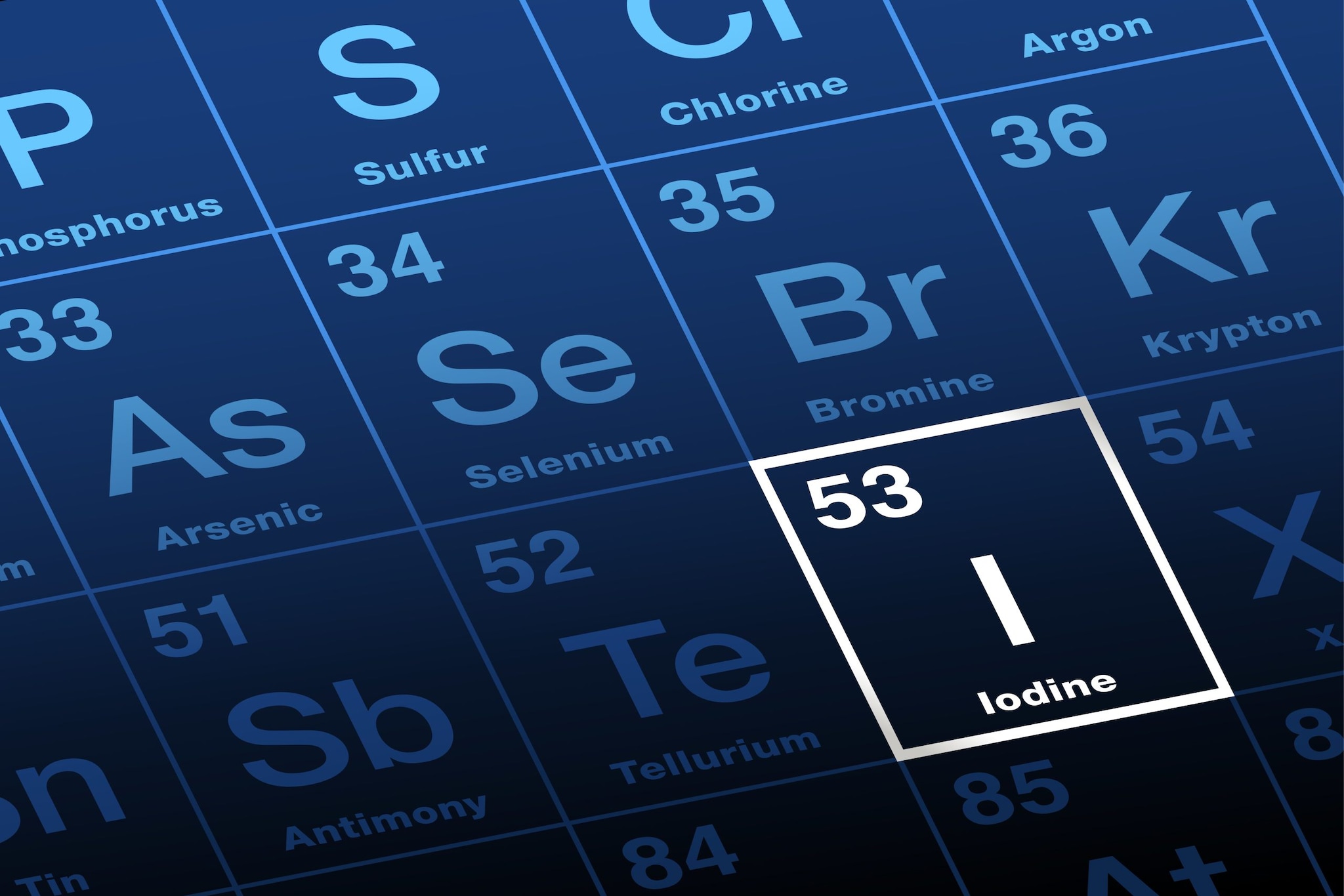At a glance
Iodine-131 (I-131) is produced commercially for medical and industrial use. Its main purpose is to diagnose and treat cancers of the thyroid gland. Large amounts of external exposure can cause burns to the eyes and skin. Internal exposure can affect the thyroid gland, a small organ located in the neck.

Iodine-131 properties
Half-life: 8.06 days
Mode of decay: Beta particles and gamma radiation
Chemical properties: I-131 can change directly from a solid into a gas, skipping the liquid phase, in a process called sublimation. I-131 dissolves easily in water or alcohol. I-131 readily combines with other elements and does not stay in its pure form once released into the environment.
Appearance: Pure I-131 is a non-metallic, purplish-black crystalline solid. However, because it readily binds with other elements, I-131 usually is found as a compound rather than in its pure form. For medical purposes, the I-131 capsules contain small granules of I-131 sodium iodide that are designed to be swallowed by patients. Liquid I-131 sodium iodide used to diagnose and treat thyroid disease is a clear liquid.
Use
I-131 is used in medicine to diagnose and treat cancers of the thyroid gland. Its main purpose is to diagnose and treat cancers of the thyroid gland.
Origin
I-131 is produced commercially for medical and industrial uses through nuclear fission. It also is a byproduct of nuclear fission processes in nuclear reactors and weapons testing.
Form
In medicine, I-131 is supplied in capsules or liquid of a specific activity designed to be swallowed by patients. As a product of nuclear fission, it is a dark purple gas that can be inhaled or absorbed through the skin. I-131 in fallout from nuclear weapons or reactor accidents can occur in particle form, which can be ingested in food or water.
Risks
External exposure to large amounts of I-131 can cause burns to the eyes and on the skin. Internal exposure can affect the thyroid gland, a small organ located in the neck near the Adam's apple. The thyroid gland uses iodine to produce thyroid hormones and cannot distinguish between radioactive iodine and stable (nonradioactive) iodine.
If I-131 were released into the atmosphere, people could ingest it in food products or water, or breathe it in. If dairy animals consume grass contaminated with I-131, the radioactive iodine will be incorporated into their milk. Consequently, people can receive internal exposure from drinking the milk or eating dairy products made from contaminated milk. Once inside the body, I-131 will be absorbed by the thyroid gland exposing it to radiation and potentially increasing the risk for thyroid cancer or other thyroid problems.
Iodine-131 found in surface water
Public health and Iodine-131 in surface water and rainwater
These findings were expected, given the sensitivity of our monitors and the fact that radioactive material is known to travel in the atmosphere. Federal, state, and local authorities will continue to monitor levels.
Child safety
The very low levels of radioactive material currently being measured in surface water and rainwater are far below those of public health concern.
Pet safety
Drinking rainwater contaminated with radioactive material at currently detected levels is unlikely to harm your pet.
Gardening and food safety
Food from a garden is safe. Keep in mind that it is always a good idea to wash food from your garden before you eat it.
Groups sensitive to Iodine-131 in rainwater
Infants and women who are pregnant and/or are breastfeeding are particularly sensitive to radiation. However, levels being measured now are still many times below the risk for even these groups, even for people who drink rainwater. Drinking water levels are many times below this. At this time, there is no need to take extra precautions with regard to drinking water.
Showering, bathing, and swimming
Showering, bathing, or swimming in water with the amount of radioactive material that is currently being measured will not harm your health.
Bottled water and tap water
At this time, there is no reason to switch to bottled water. State and local authorities will provide information for your community if this situation changes
Water testing
At this time, there is no need to take extra precautions with regard to drinking water.
States and the federal government routinely conduct water monitoring for safety and are working to ensure that drinking water does not pose a health risk to people in the US.
Current understanding
Given the uncertainty related to the nuclear reactors in Japan, we don’t know how levels of radiation currently seen in surface water and rainwater will change in the immediate time period. However, we do know that I-131 disappears relatively quickly in the environment.
Who to contact for information
The best source of information about your community is your local drinking water program or department, or your state environmental protection division or program.
Iodine-131 found in milk
How Iodine-131 collects in milk
Airborne I-131 that deposits on pastures may be consumed by dairy cows. A portion of the I-131 consumed by a cow would then be transferred into the cow’s milk.
Cow and goat milk
Historically, when cow’s milk has been affected by I-131, so has goat’s milk.
Groups most sensitive to Iodine-131 in milk
The developing fetus, newborns, infants and young children are particularly sensitive to I-131.
Iodine-131 and thyroid health
The level of I-131 that would affect thyroid health depends on many factors. Developing fetuses, newborns, infants, and young children are particularly sensitive to I-131. The FDA’s level for intervention is conservative and provides a large safety margin to protect public health.
More information
- Frequently Asked Questions (FAQs) About a Radiation Emergency
- What to Do in Radiation Emergencies
- About Potassium Iodide (KI)
- Radiation Dictionary
- Public Health Statement for Iodine (Agency for Toxic Substances and Disease Registry)
- Iodine Basics (Environmental Protection Agency)
